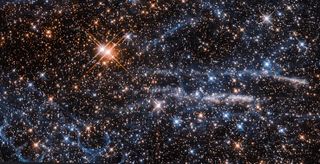Tarantula Nebula Unfurls Like a Cosmic Spider in Stunning Hubble Telescope Image

A stunning image from the Hubble Space Telescope reveals the glimmering Tarantula Nebulathat sits within one of the Milky Way's closest neighbors, a small satellite galaxy called the Large Magellanic Cloud. The image was released recently in a statement from NASA.
The Tarantula Nebula is the most active star-forming region in our galactic neighborhood. If it were as close to Earth as the Orion Nebula — the closest of these stellar nurseries, which is only 1,344 light-years away — it would take up the same area in the sky as 60 full moons and would be bright enough to cast shadows on the ground, according to a statement from the National Optical Astronomy Observatory (NOAO).
The region is so active because it's located exactly where stars and gas from the nearby Small Magellanic Cloud are being pulled into the Large Magellanic Cloud, NOAO officials said in the statement. This stolen material slams into the gas in the Large Magellanic Cloud, and the shock waves fuel star formation. [In Photos: The Spookiest Nebulas in Space]
The energy can also lead to higher numbers of large, unstable stars. Scientists were treated with a wealth of data when one of these stars went supernova in 1987. For observers in the Southern Hemisphere, the exploding star was visible to the naked eye for several months, and it's still quite bright 30 years later. Dubbed Supernova 1987A, it was the closest supernova to be observed since 1604.
While looking for the remnants of Supernova 1987A, scientists stumbled upon the Tarantula Nebula's neighbor, the Honeycomb Nebula. The Honeycomb Nebula's peculiar cells have baffled scientists since its discovery, but now astronomers believe supernovas are also at the root of this phenomenon.
In 2010, a research team at the University of Manchester, in the United Kingdom, studied the wavelengths of light released by the Honeycomb Nebula and found that it matched light emitted by other supernovas. The astronomers suggested that the Honeycomb Nebula's unique appearance may be the result of ripples that formed as the debris from an ancient supernova was hit by the blast of a more recent one. Regardless of the nebula's origin, the team suspects its striking appearance results from our unique viewing angle here on Earth.
Email Harrison Tasoff at htasoff@space.com or follow him @harrisontasoff. Follow us @Spacedotcom, Facebook and Google+. Original article on Space.com.
Get the Space.com Newsletter
Breaking space news, the latest updates on rocket launches, skywatching events and more!
Join our Space Forums to keep talking space on the latest missions, night sky and more! And if you have a news tip, correction or comment, let us know at: community@space.com.

Harrison Tasoff is a science journalist originally from Los Angeles. He graduated from NYU’s Science, Health, and Environmental Reporting Program after earning his B.A. in mathematics at Swarthmore College. Harrison covers an array of subjects, but often finds himself drawn to physics, ecology, and earth science stories. In his spare time, he enjoys tidepooling, mineral collecting, and tending native plants.
